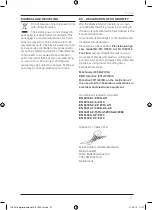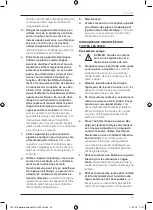
27
English
.
Cutting Depth
1. The depth of cut can be set in millimetres
by adjusting the cutting depth limiter (3).
Open the silver lever and slide the depth
limiter and fasten it when the end of the
safety cutting shoe lines up with the
desired depth figure on the scale.
2. When cutting wood, the depth of cut
should be set slightly greater than the
thickness of the material for best results.
3. When cutting plastics the depth of cut
should be set slightly greater than the
thickness of the material. If melting occurs,
a greater depth setting will improve
results.
4. When cutting metals, the depth of cut
should be set to approximately 1.0 mm
greater than the material thickness for
best results.
The depth can be set to the same as the mate-
rial thickness when cutting wood or plastics to
prevent marking of the surface below. This
may result in a rough edge on the other side of
the work piece.
Marking the Cuts
When making cut outs it is desirable to know
exactly where the cut will start and stop to
prevent unsightly over cutting. Indication num-
bers, which correspond to the depth setting,
are marked on the safety cutting shoe to show
where the cut starts and stops.
1. Mark the area to be cut out on the material
to be cut. If the area is not a square or
rectangle, separate start and finish lines
may have to be drawn. These are drawn
from the start and finish point, at right
angles to the line of cut.
2. To use the width indication system first set
the cutting depth, for example 9 mm.
3. Identify this number (e.g. 9) both on the
side of the safety cutting shoe.
4. Align the indication mark below the rear-
most number on the safety cutting shoe
with the start line on the material to be cut.
5. Proceed with the cut until the indication
mark below the forward number aligns
with the finish line on the material being
cut.
Dust Extraction
This saw is a powerful tool which produces a
large amount of dust. As the tool has a fully
enclosed blade, forced dust extraction is par-
ticularly efficient. An industrial vacuum dust
extractor or a vacuum cleaner for domestic use
can be connected to the dust extractor flange
(6) of the tool, using the dust hose kit.
• To attach the hose disconnect the tool
from the mains supply. Press the hose end
onto the dust extractor flange (6). Ensure
the safety cutting shoe can still move
smoothly. Press the stepped adapter onto
the vacuum hose. Tape can be used to
seal up, if required.
• Ensure that the vacuum cleaner is recom-
mended for use with a power tool. Gener-
ally most wet and dry vacuum cleaners for
domestic use are suitable.
• Forced dust extraction is particularly rec-
ommended when many cuts are carried
out as far fewer stoppages are required for
cleaning the tool and surrounding area.
• Forced dust extraction should always be
used when cutting hazardous materials
such as hard woods, MDF or ceramics.
Forced dust extraction is recommended when
it is desirable to keep the working area clean. If
the material being cut is slightly damp, it is
essential to use forced dust extraction.
Speed Regulation
With the buttons (A) and (B) the speed of the
saw blades can be set. The set speed is
shown in the display. During operation the
blocks in the right part of the display indicate
the drop of speed under load. If the machine is
overloaded the LED of the overload protection
flashes or lights up. In this case reduce the
advance rate and observe points 9 and 10 of
the chapter “
Cutting
” and the chapter “
Over-
load Protection
”.
Selecting the Speed
When setting the speed observe the recom-
mendations of the manufacturer of the saw
blades. Additionally here are a few guidelines:
Plexiglas: . . . . . . . . . . . . . . 4000 min
-1
Laminate: . . . . . . . . . . 4000 – 6000 min
-1
Soft Metal: . . . . . . . . . 4000 – 6000 min
-1
MDF Board: . . . . . . . . 6000 – 8000 min
-1
Wood: . . . . . . . . . . . . . . . 8000 min
-1
Plywood: . . . . . . . . . . . . . . 8000 min
-1
7062413-digital-display-MA-#-1604-19.indb 27
11-05-16 11:37
















































